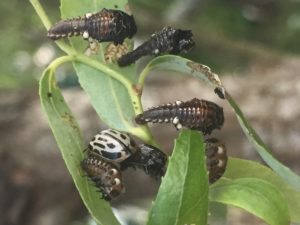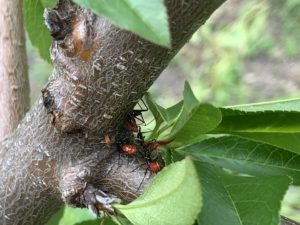Bugs, Bugs, Bugs!
go.ncsu.edu/readext?692954
en Español / em Português
El inglés es el idioma de control de esta página. En la medida en que haya algún conflicto entre la traducción al inglés y la traducción, el inglés prevalece.
Al hacer clic en el enlace de traducción se activa un servicio de traducción gratuito para convertir la página al español. Al igual que con cualquier traducción por Internet, la conversión no es sensible al contexto y puede que no traduzca el texto en su significado original. NC State Extension no garantiza la exactitud del texto traducido. Por favor, tenga en cuenta que algunas aplicaciones y/o servicios pueden no funcionar como se espera cuando se traducen.
Português
Inglês é o idioma de controle desta página. Na medida que haja algum conflito entre o texto original em Inglês e a tradução, o Inglês prevalece.
Ao clicar no link de tradução, um serviço gratuito de tradução será ativado para converter a página para o Português. Como em qualquer tradução pela internet, a conversão não é sensivel ao contexto e pode não ocorrer a tradução para o significado orginal. O serviço de Extensão da Carolina do Norte (NC State Extension) não garante a exatidão do texto traduzido. Por favor, observe que algumas funções ou serviços podem não funcionar como esperado após a tradução.
English
English is the controlling language of this page. To the extent there is any conflict between the English text and the translation, English controls.
Clicking on the translation link activates a free translation service to convert the page to Spanish. As with any Internet translation, the conversion is not context-sensitive and may not translate the text to its original meaning. NC State Extension does not guarantee the accuracy of the translated text. Please note that some applications and/or services may not function as expected when translated.
Collapse ▲We have bugs all around us however, many we have never seen before and do not know if they cause damage. What if they bite or sting? Which ones should we stay away from and which ones should we worry about doing damage to our plants? Which ones are beneficial, working for us to keep our plants clean?
I responded to three such questions this week. I also found a few beneficial insects on my peaches this week, but they are still insects not to be reckoned with!
So far this spring, I have had three calls about these little ugly bugs that are on fig branches. One caller described them as little armored dots, another stated they were everywhere and she was sure they would kill her figs. The last caller thought they were stink bugs attacking her figs. Rest assured, oftentimes there is a threshold of damage that our plants can sustain without lasting harm or loss of production. In the case of kudzu bugs (Megacopta cribraria), it is better to get them off of the tree if possible but chances are, they will not do much harm to the tree, even in large numbers.
According to NC State Extension Specialist in Household & Structural Entomology, Mike Waldvogel, this insect tends to gather in large numbers on houses and other structures as well, becoming a real nuisance. Dominic Reisig, NC State University Professor and Extension Specialist in Entomology and Plant Pathology, states that kudzu bugs are a pest of agronomic crops too such as soybeans and other legumes. He recommends scouting crops on a regular basis and using thresholds for effective management of this pest.
If you come across them in your home garden you have two options. You can brush them off into a bucket of soapy water (two teaspoons liquid dish detergent to 1 gallon of water). Make certain not to squish them or handle them with bare hands because they do emit a toxin that can cause hands to welt and swell. Your second option is to use an insecticide such as a pyrethroid. Pyrethroids are formulations that have bifenthrin, permethrin, lambda-cyhalothrin or anything else ending in “-thrin” as the active ingredient. These are sold, quite literally, under thousands of trade names and are available at most any local hardware store.
Always read the label of any chemical you are using in its entirety, wear the appropriate personal protective equipment, and apply the chemical as directed. Remember too, using an insecticide often harms beneficial insects leading to a spike in other plant pests such as spider mites. Beneficial insects that have been observed to prey on the kudzu bug are the assassin bug (Arilus cristatus) and the predatory stink bug (Euthyrhynchus floridanus). If you see these insects, think twice about spraying an insecticide!
The second insect question I had was from a caller that had willow leaf beetles
(Chrysomela scripta). These are insects that overwinter as adults, lay eggs, and then the larvae which pupate into adults. They had larvae in their flowers, bushes, and a corkscrew willow tree that will eat the leaves of the trees mostly and then disperse to other plants to pupate. These insects go by several names, two such aliases are the Cottonwood leaf beetle and the Poplar leaf beetle. Lady beetles are known to prey on these insects so be on the lookout for their help in controlling this pest. It is not recommended to use an insecticide on these beetles unless you have large numbers on a small tree. In such case, a pyrethroid as mentioned above will do the trick.
Now to talk about the insect I found on my peaches. This was a nymph of the
assassin or wheel bug. Although a welcomed visitor to my plants, I do not dare handle them! I understand the bite packs a wallop, being described as much worse than a wasp sting. The wheel bugs I found were still in one of the five nymphal stages of development.
If you have an insect in your plants or yard, email me a picture and we can get down to the bottom of it. Knowing if it is beneficial or problematic and what to do about it is key in controlling pests.







